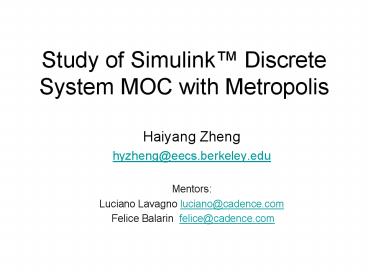Study of Simulink Discrete System MOC with Metropolis - PowerPoint PPT Presentation
1 / 20
Title:
Study of Simulink Discrete System MOC with Metropolis
Description:
Simulink Discrete System MOC. MOC Implementation in ... YOYO. YYYO. C. A. YYYO. D. YYYY. The sorted block order is ABCD. Outline. Motivation and Introduction ... – PowerPoint PPT presentation
Number of Views:63
Avg rating:3.0/5.0
Title: Study of Simulink Discrete System MOC with Metropolis
1
Study of Simulink Discrete System MOC with
Metropolis
- Haiyang Zheng
- hyzheng_at_eecs.berkeley.edu
- Mentors
- Luciano Lavagno luciano_at_cadence.com
- Felice Balarin felice_at_cadence.com
2
Outline
- Motivation and Introduction
- Simulink Discrete System MOC
- MOC Implementation in Metropolis
- A tool for automatic transformation of Simulink
models into Metropolis models - Simulation Demos
- Acknowledgement and Conclusion
3
Motivation
- Simulink MOC is a heterogeneous one. A
non-trivial model contains both discrete and
continuous models. - A complex mixture model is usually hard to
design, understand, and maintain. - A better way is to use some simpler, better
defined MOCs to model different parts of the
complex system.
4
Introduction
- Discrete time points
- Continuous time intervals
- We choose purely discrete (sampled data) system
as the study object.
5
Outline
- Motivation and Introduction
- Simulink Discrete System MOC
- MOC Implementation in Metropolis
- A tool for automatic transformation of Simulink
models into Metropolis models - Simulation Demos
- Acknowledgement and Conclusion
6
Discrete System in Simulink
B
A
C
- Each block in the block diagram has a sample
time, the rate at which it executes during
simulation. - Multi-rate discrete systems contain blocks
sampled at different rates. - Simulator takes the simulation step as the
fundamental sample time, the greatest common
divisor of the systems actual sample times.
7
Outline
- Motivation and Introduction
- Simulink Discrete System MOC
- MOC Implementation in Metropolis
- A tool for automatic transformation of Simulink
models into Metropolis models - Simulation Demos
- Acknowledgement and Conclusion
8
Metropolis meta-model
- Netlist design of model (aggregation of objects
and ports) - Objects
- Process thread doing computation
- Medium
- Media for communication between processes
- State Media for communication between process and
scheduler - Scheduler defines policies to satisfy
constraints - Port Interface
- provides functions reference of other objects
- Constraint
9
Discrete MOC in Metropolis I
- Processes communicate through channels, the
medium. - Each process has a period parameter, which is
stored in the associated state medium.
10
Discrete MOC in Metropolis II
- The scheduler calculates the schedule based on
the sampled rates and invokes different processes
periodically. - The scheduler forces the finish of execution of
processes to ensure the data precedence. - The data dependency is not analyzed in the
scheduler but in the model design phase.
11
Outline
- Motivation and Introduction
- Simulink Discrete System MOC
- MOC Implementation in Metropolis
- A tool for automatic transformation of Simulink
models into Metropolis models - Simulation Demos
- Acknowledgement and Conclusion
12
An Example Model
13
Metropolis MMM Netlist
- public netlist simple
- public simple (String name)
- dtScheduler dtscheduler new
dtScheduler("dtscheduler", 4) - addcomponent (dtscheduler, this)
- RampProcess DiscreteRamp new
RampProcess("DiscreteRamp", 0, 2) - addcomponent(DiscreteRamp,this,"DiscreteRamp")
- dtStateMedium s0 new dtStateMedium("StateMed
ium0", 0.25) - addcomponent (s0, this)
- connect (DiscreteRamp,smport,s0)
- connect (dtscheduler, StateMedium0, s0)
- connect (dtscheduler, processPeriod0, s0)
- dtchannel c0 new dtchannel("c0")
- addcomponent(c0,this,"channel0")
- connect(DiscreteSubtract,outports0,c0)
- connect(Scope,inports0,c0)
14
Comparison
An automatic transformation from the block
diagram representation to the text representation
is necessary.
15
A Tool for Transformation from Simulink models
into Metropolis models
- Transformation from Simlink Models into XML
representations using MatlabUDM, a tool from
Vanderbilt University. - Transformation from XML representations into
Metropolis MMM netlists with XSLT based tool. - Two contributions
- It bridges the tools of Simulink and Metropolis
with XML. - It sorts the blocks based on data dependency
analysis.
16
Design of the Tool Data Dependency Analysis
Given order of blocks as BCAD.
- Conditions for processes to
- be ready to execute
- There is no input.
- All inputs are available.
- Algorithm
- Construct a status array with length as the
number of processes and initiate it with O
indicating the process not scheduled. - Iterate the processes with given order, mark the
ready process as Y, and schedule it. Repeat until
all processes are marked and scheduled.
The sorted block order is ABCD.
17
Outline
- Motivation and Introduction
- Simulink Discrete System MOC
- MOC Implementation in Metropolis
- A tool for automatic transformation of Simulink
models into Metropolis models - Simulation Demos
- Acknowledgement and Conclusion
18
Demos (Results)
- A Simulink Model
- Simulation result
- A Metropolis Model
- Simulation with code generated from SystemC
Result of Ramp is 1 Result of Ramp is 2 Result
of Gain is 4 Result of Subtract is 2 Outputis
2 Result of Ramp is 3 Result of Ramp is
4 Result of Gain is 8 Result of Subtract is
4 Outputis 4 Result of Ramp is 5 Result of Ramp
is 6 Result of Gain is 12 Result of Subtract
is 6 Outputis 6
19
Outline
- Motivation and Introduction
- Simulink Discrete System MOC
- MOC Implementation in Metropolis
- A tool for automatic transformation of Simulink
models into Metropolis models - Simulation Demos
- Acknowledgement and Conclusion
20
Acknowledgement Conclusion
- Thanks to
- Advice from Luciano Lavagno and Felice Balarin.
- Guang Yangs help on the C-code generation of
Metropolis models with SystemC. - ISIS of Vanderbilt University providing the
MatlabUDM tool. - A Discrete (Sampled Data) MOC is implemented in
Metropolis. - A transformation tool from Simulink XML models to
Metropolis MMM netlists is implemented.































